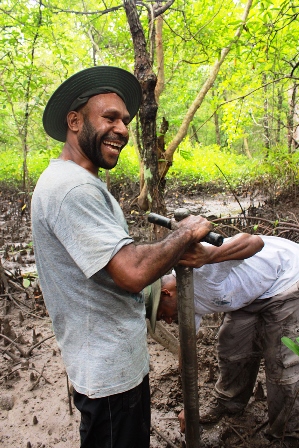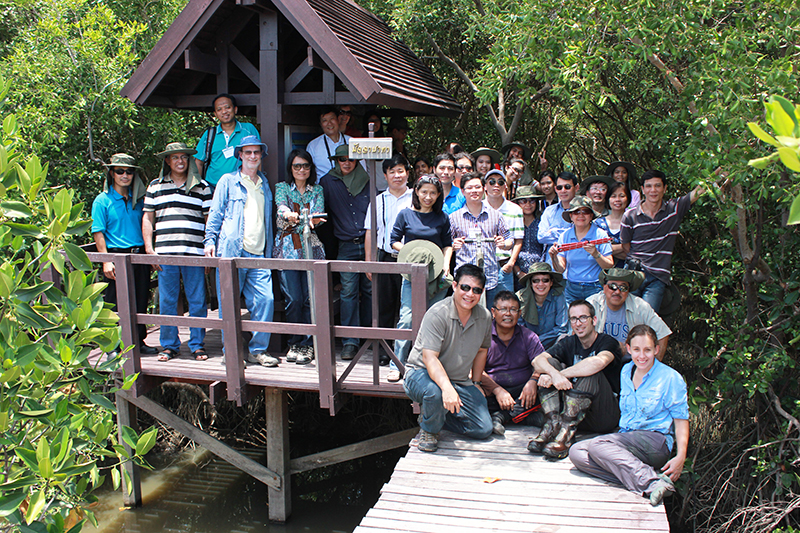The Asian Greenhouse Gas Management Center (AGMC) is a new regional facility that serves as an “...
Asian Experts Get Muddy to Calculate Carbon in Mangroves

Field Training on Carbon Stock Assessment and Emissions Inventory in Asian Mangroves
Trang, Thailand - Forested wetlands, including mangroves, peat swamps, cypress domes, and related ecosystems, are believed to hold some of the highest carbon densities among terrestrial (soil and vegetation) systems. In the Indo-Pacific region, mangroves cover as much as 6.8 million hectares, or approximately 40 percent of world's total, and it is estimated that these ecosystems store more than five times the amount of carbon compared to tropical upland forested ecosystems (not including peatlands). They provide a wide range of products and services to both the communities living near them and the economies of countries in the region, yet these ecoststens are threatened by conversion to aquaculture and agriculture, urban development, overexploitation, and other deforestation and degradation.
F rom April 29 to May 8, 2013, the LEAD program and the USAID-supported Sustainable Wetlands Adaptation and Mitigation Program (SWAMP), in collaboration with USAID’s Lowering Emissions in Asia’s Forests (LEAF) program, conducted intensive field training in Trang Province, Thailand for 31 participants from eight Asian countries on application of a new protocol developed by SWAMP for measuring and monitoring carbon stocks in, and greenhouse gas (GHG) emissions from, mangroves and other forested wetlands. SWAMP is a collaborative effort by the Center for International Forestry Research (CIFOR), the USDA Forest Service (USFS), and Oregon State University, with support from USAID. [Watch a short video about the training]
rom April 29 to May 8, 2013, the LEAD program and the USAID-supported Sustainable Wetlands Adaptation and Mitigation Program (SWAMP), in collaboration with USAID’s Lowering Emissions in Asia’s Forests (LEAF) program, conducted intensive field training in Trang Province, Thailand for 31 participants from eight Asian countries on application of a new protocol developed by SWAMP for measuring and monitoring carbon stocks in, and greenhouse gas (GHG) emissions from, mangroves and other forested wetlands. SWAMP is a collaborative effort by the Center for International Forestry Research (CIFOR), the USDA Forest Service (USFS), and Oregon State University, with support from USAID. [Watch a short video about the training]
Field practitioners and policy makers from Cambodia, Indonesia, Malaysia, Papua New Guinea, Philippines, Singapore, Thailand, and Vietnam participated in the collaborative nine-day training aimed at providing them with credible scientific information needed to make sound decisions related to the role of tropical wetlands in climate change adaptation and GHG mitigation strategies. The course included sessions on the concepts and science of the protocol, a newly developed method that is informing the Intergovernmental Panel on Climate Change (IPCC) 2013 Wetlands Supplement (forthcoming) to the 2006 National Greenhouse Gas Inventory Guidelines. Participants then spent four days in mangrove forests gathering data using the protocol methodologies for four different types of mangroves, and two days learning how to process field samples and make preliminary calculations of carbon stocks. The participants also brainstormed options for building national communities of practice and a regional network of mangrove specialists, and produced action plans for future training and capacity building in their countries.
To see more photos, click here.
Carbon Stock Assessment and Emissions Inventory in Asian Mangroves: Executive Summary for Policy Makers
Bangkok, Thailand - Prior to the field training, on April 24-26, the LEAD program and SWAMP programs jointly held a short course for 36 government officials from seven Association of Southeast Asian Nations (ASEAN) countries on the benefits of mangroves and their ecosystem services for coastal communities in the region, the role of mangroves in greenhouse gas mitigation and adaptation to climate change, the protocol developed by SWAMP for carbon stock assessment in mangroves, and carbon finance options for mangrove projects. The classroom sessions were followed by a day-long field trip to the Leam Phak Bia mangrove rehabilitation project to better understand application of the new protocol. Through the training, ASEAN policy makers increased their understanding of the need for consistent methodology in conducting carbon stock assessments, as well as the importance of including mangroves in reporting through national greenhouse gas emissions inventories. Conducted in collaboration with the USAID LEAF program and the Food and Agriculture Organization (FAO), the training is part of LEAD and SWAMP efforts to support wider dissemination across Asia of standard protocols for carbon accounting of mangroves and other forested wetlands.
For more information about the trainings, please contact Amornwan "Mai" Resanond of the LEAD program at: Amornwan.Resanond@icfi.com
To see more photos, click here.







